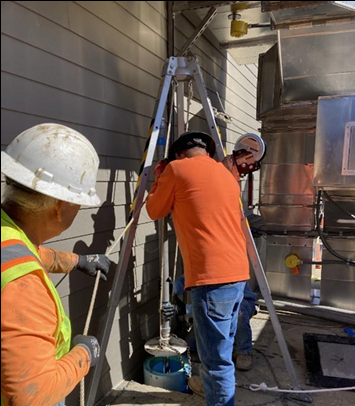
Pump Station M (PSM) serves as a crucial pumping station for Bay Farm Island, a residential community of about 15,000 people. The station pumps an average of 2 million gallons of wastewater daily, with peaks up to 5.8 million gallons during winter months. Prior to rehabilitation, PSM lacked a flow meter, programmable logic controller (PLC), and any for remote wastewater flows monitoring or control system. Odor control system also left much to be desired.
For years, PSM used sodium hypochlorite to treat odors, but its effectiveness was inconsistent. It took too long and produced sub-optimal results. The facility’s dosing system was inefficient—chemicals had to be stored in a large tank and delivered regularly, taking up valuable space and increasing safety risks from chemical handling. In 2016, signs of leakage in the storage tank highlighted additional safety concerns, prompting a reevaluation of odor control strategies.
The sodium hypochlorite system, an old industry standard, proved inadequate for PSM. The station was dosed at a maintenance hole upstream of the station. Its delayed action meant odors were not effectively controlled at the source. The system had several inherent limitations:
Given these challenges, EBMUD sought a more reliable, cost-effective, and sustainable solution that would not only improve odor control, but also enhance the facility’s operational safety and reliability.
The design team at West Yost Engineers was tasked with finding a better alternative to hypo dosing. Several technologies were explored:
Most promising was the Advanced Oxidation Process (AOP), utilizing ozone generation in conjunction with carbon adsorption for odor control. The AOP system at PSM consists of two Titus Wastewater Solutions ozone generators that produce up to 40 grams of ozone per hour when both are operating. These generators work by creating a corona discharge, which ionizes the air and converts oxygen into ozone, a potent oxidizer that reacts with odor-causing compounds in wastewater.
The ozone generators were housed in stainless steel enclosures with noise-reducing padding, air conditioning, and particulate filters, to maintain an optimal operating environment. A key safety feature of the AOP system is the integration of O3 sensors that automatically shut down the system if ozone levels exceed safe thresholds. This ensures that operators can safely monitor and maintain the system.
In addition to ozone generators, Titus Twister mixing aerators were installed in the wet well to help distribute the ozone throughout the wastewater and improve mixing. These aerators serve multiple purposes:
The installation of the Twister aerators was straightforward, and they worked in tandem with the ozone generators to enhance the overall odor control system. The aerators can also operate without ozone to provide agitation, further improving wastewater quality and pump performance.
The Bay Area Air Authority limited the amount of ozone that could be injected into the wet well, somewhat limiting the AOP system’s effectiveness. While it neutralized most odors, some remained, which was addressed with the addition of carbon canisters. They were installed downstream of the AOP system to adsorb any remaining hydrogen sulfide (H2S) gas. Each canister is filled with 140 pounds of activated carbon, capturing odor-causing contaminants. As the ozone injected into the wastewater eliminates most of the dissolved sulfides, and thus the H2S gases, the carbon filters should need very little maintenance.
The installation of the AOP system was completed with minimal disruption to the overall rehabilitation project. The most significant result was a drastic reduction in odor complaints. Prior to the upgrade, average hydrogen sulfide (H2S) gas levels in the wet well were 2.8 parts per million (ppm). After the AOP and carbon canisters were installed, H2S levels dropped to just 0.4 ppm, and no further odor complaints have been received.
This upgrade not only resolved odor issues but also eliminated the need for hazardous chemical deliveries and significantly reduced operation and maintenance costs. Most importantly, the switch to AOP technology has created a safer, more reliable, and environmentally friendly wastewater treatment facility for the surrounding community.
The project was considered such a breakthrough success that a paper on the project was recognized by the California Water Environment Association for Engineering Achievement on February 7, 2025.
Installation Site: Pump Station M
Collection System Size: 2 million MGD to 5.8 million MGD
West Yost Engineers
N/A